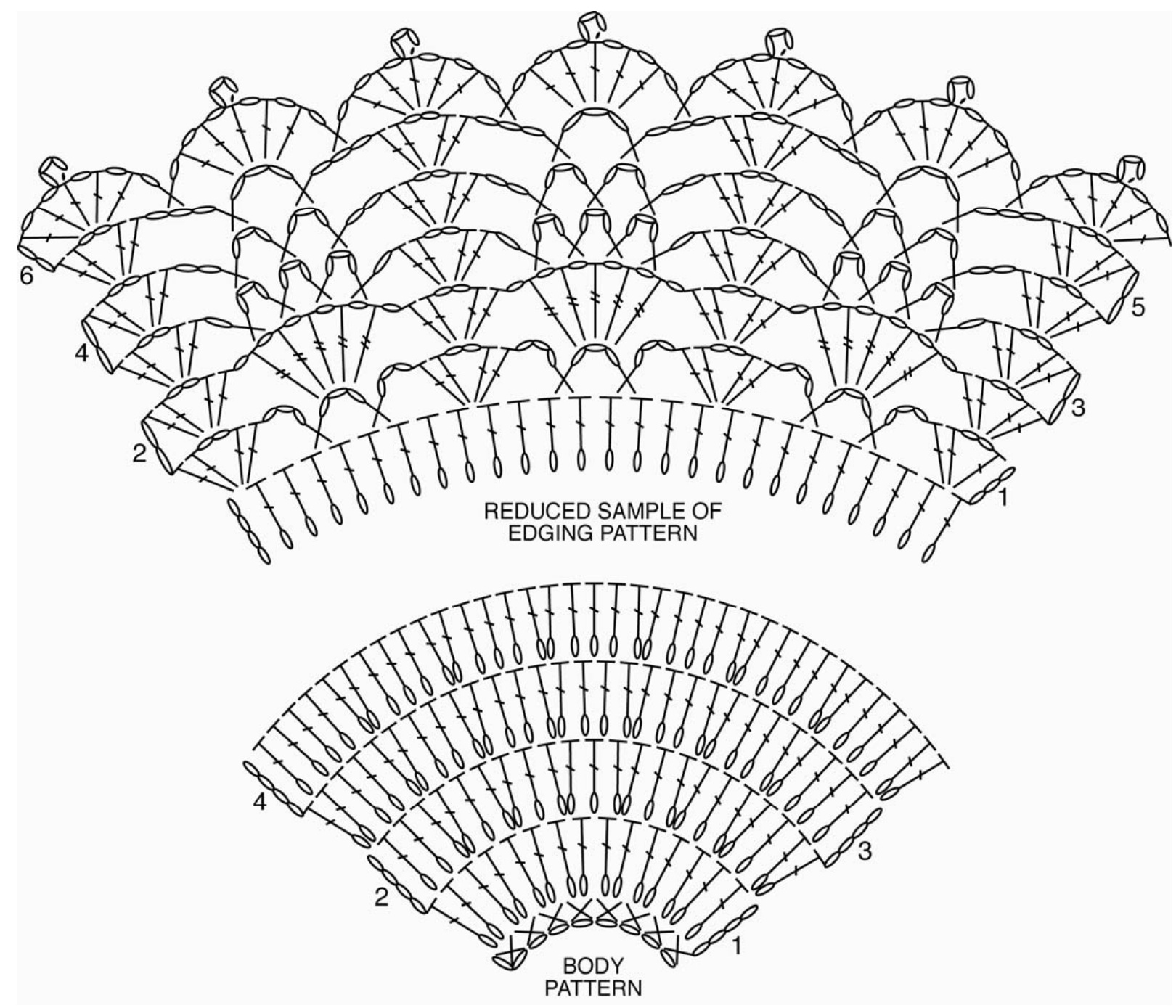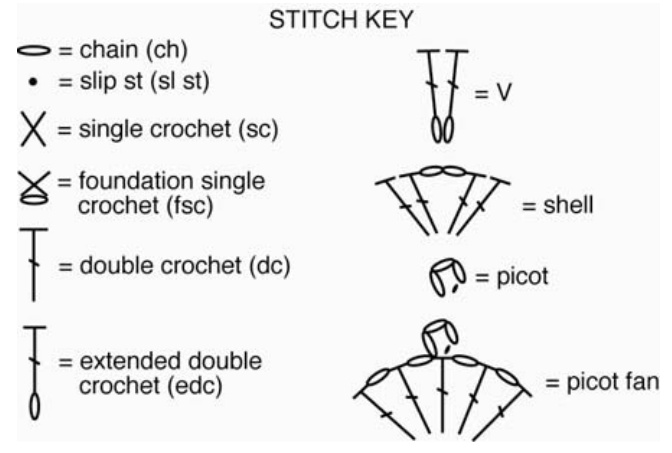A Design by Doris Chan
THE ALL SHAWL
A. Long B. Short C. Chunky D. Funky
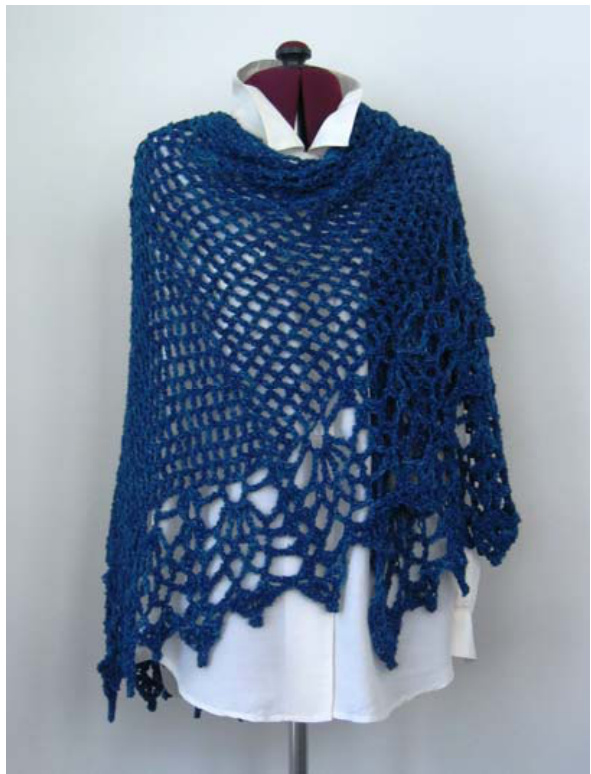
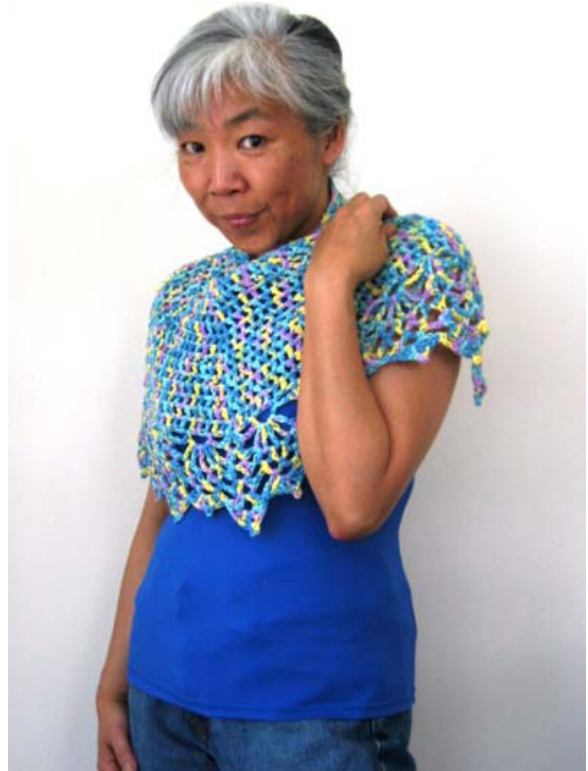
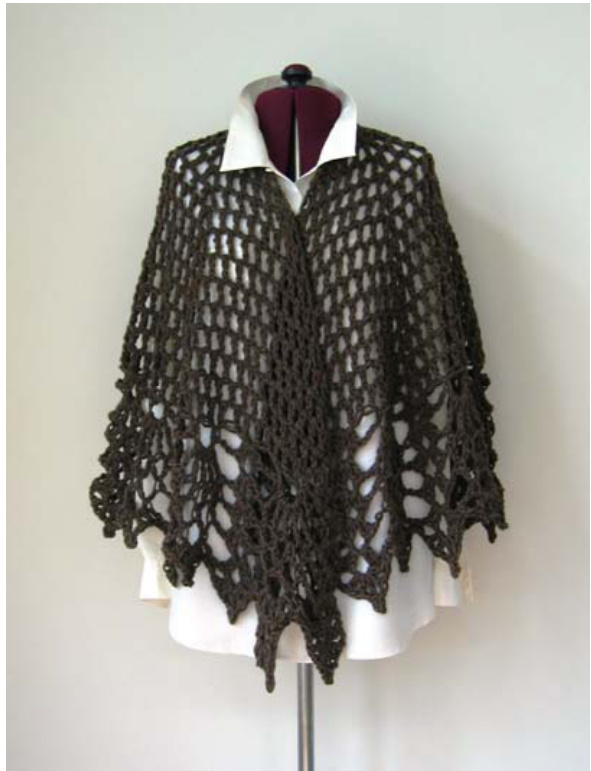
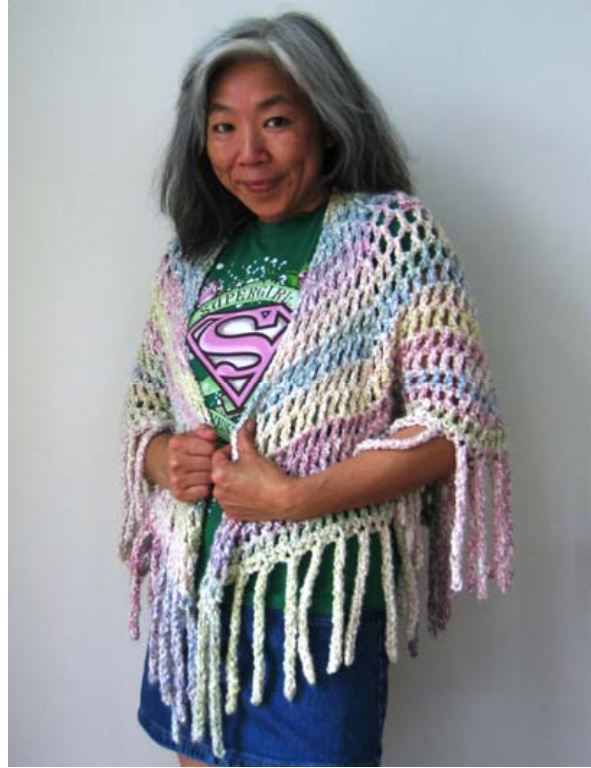
THE ALL SHAWL
Just for my crochet friends on Ravelry and visitors to my Everyday Crochet blog, 'm sharing an early shawl design that I never thought to publish. Quick to crochet, this rounded shawl is shaped like a pie with a wedge missing and finished with a lacy edge. The open fronts are slightly extended for a bit of extra fabric to wrap around your body and throw over your shoulder. Not every crocheter is comfortable with wandering off the printed pattern path. The whole idea of this pattern is to get you thinking about just that -- customizing designs. I've included tips and suggestions for yarn substitutions so you can make your own All Shawl in virtually any yarn, any gauge and any length you desire. Because of the allseason possibilities, this garment is way more versatil than a scarf and just as efficient to make for yourself, for giving and sharing. The Long version (A) is a great length for cool weather layering. It can be tossed over jackets, sweaters or even draped decoratively over your coat. I saw, scooped up and stashed one huge hank of this heavy worsted wool blend boucle from Judy Ditmore's Interlacements during a conference last year. You know how yarn can sometimes talk to you? Well, this one asked to be made into a shawl. This is what I throw over my PJs to run to the mailbox! For summertime try the Short version (B), rather like a glorified scarf. When it's 95 degrees in the shade but 55 degrees inside with AC blowing on the back of your neck, it's useful to take along a litle comfy cover-up. The yarn is the star here, a knitted tape yarn in corn fiber, which has a cool hand and a lovely, dense but breathable drape when broken in. I would take this teeny-tiny thing to the movies or to CGOA summer conference classrooms where environmental controls are not in your control. The third sample is the maximum exploded Chunky version (C) made with Classic Elite Duchess, a bulky but elegant blend of merino, cashmere and angora. The mesh body has fewer rows than the previous short version (because I ran out of yarn), but amazingly the finished shawl blocks to the same size as the long version. Surprisingly it is not all that heavy, but roomy and warm. And just for fun, there's the goofy sample, a blast from my past. The Funky version (D) uses a slightly different closer mesh, but the concept is the same. It's done in a cozy soft, chunky variegated yarn, which already has so much interesting texture and color I opted for some crocheted fringe instead of lace edging.
SKILL LEVEL
The main body of AII Shawl is EASY. The lace part might be EASY-ish INTERMEDIATE (not gene-splicing, but no a first-time project) SIZE fits many; see suggestions below for a wider fit Finished, blocked measurements Long Version: $_{25"}$ back length, $60^{\circ}$ front edge Short Version: 14" back length, 38" front edge Chunky Version: $26"$ back length, $62^{\circ}$ front edge Funky Version: $18"$ back length plus $6"$ fringe, 50" front edge plus fringe
THE ALL SHAWL
MATERIALS (samples as shown)
Long Version: Interlacements Boucle Blend Il; $60\%$ Wool, $40\%$ Nylon; 16 oz/approx 775 yd; one skein in color 255 blues; Size K-10.5 $.6.5\;\mathrm{mm}$ crochet hook

Short Version: South West Trading Company Amaizing; $100\%$ Corn Fiber; 1.75 yd (50 $\mathfrak{g})/140$ yd $\left.\left[130\;\mathrm{m}\right)\right.$ ; 4 balls in #164 Childs Play; Size J-10 ( $\left(6\;\mathsf{m m}\right)$ crochet hook Chunky Version: Classic Elite Duchess; $40\%$ Merino, $28\%$ Viscose, $10\%$ Cashmere, $7\%$ Angora, $15\%$ Nylon; 1.75 oz $(50\;\mathfrak{g})/75$ yd; 7 balls in #1076 Baronet's Brown; Size M $(9\,\mathsf{m m})$ crochet hook Funky Version: Lion Brand Homespun; $98\%$ Acrylic, $2\%$ Polyester; 6 oz (170 g)/185 yd $(169\,\mathsf{m})$ ; 2 skeins in #315 Tudor; Size L ( $(8\,\mathsf{m m})$ crochet hook
GAUGE
Exact gauge not critical; in mesh patten of body: Long Version: 8 st and 5 rows $=4^{\ast}$ Short Version: 10 st and 7 rows $=4^{\ast}$ Chunky Version: $6\;{\sf s t}=4^{*}$ , $5\;\mathsf{r o w s}=6^{\ast}$ Funky Version: 6 st and 4 rows $=4^{\ast}$ (worked in dc mesh)
STITCHESANDABBREVIATIONS USED
Ch (chain) Ch-sp (chain-space) Dc (double crochet) Sc (single crochet) Sl st (slip stitches) Sp (space or spaces) Tr (triple or treble crochet) YO (yarn over)
SPECIAL STITCHES
Fsc (foundation single crochet): Start with a slip knot, ch 2,insert hook in 2nd ch from hook, YO and draw up a loop, YO and draw through one loop (the "chain"), YO and draw through 2 loops (the "sc"). The following stitch is worked under the forward 2 loops of the stem of the previous stitch (into the "chain"). Insert hook into the face of the “chain" and under the nub at the back of the “chain", YO and draw up a loop, YO and draw through one loop (the "chain"), YO and draw through 2 loops (the "sc"). Repeat for the length of foundation. Edc (extended double crochet): YO, insert hook in next space or stitch, YO and draw up a loop (3 loops on hook), YO and draw through one loop on hook (3 loops on hook), (YO and draw through 2 loops on hook) 2 times NOTE: Mesh patern is worked in extended double crochet made in the space between stitches throughout unless otherwise stated. To make each stitch, instead of inserting the hook into the top loops of the next stitch, insert the hook in the next BIG space in-between stitches. If done in a loose gauge, the fabric is not all that much bulkier than normal stitches. This technique is briliant when working with yarns that tend to split or with novelty yarns that are majorly busy and the loops are difficult to see.
THE ALL SHAWL
V: 2 edc in same place V in V: 2 edc in space between the 2 edc of next V SH (shell): 2 dc, ch 2, 2 dc] all in same space SH in SH: make shell in ch-2 space of next shell Picot: After completing a dc, ch 3, reach back and insert hook from top to bottom into front two strands of dc just made,like going back through the path of the last step of the dc, sl st to close picot. PICOT FAN: [(dc, ch 1) 2 times, dc, Picot, (ch 1, dc) 2 times] all in same ch-sp
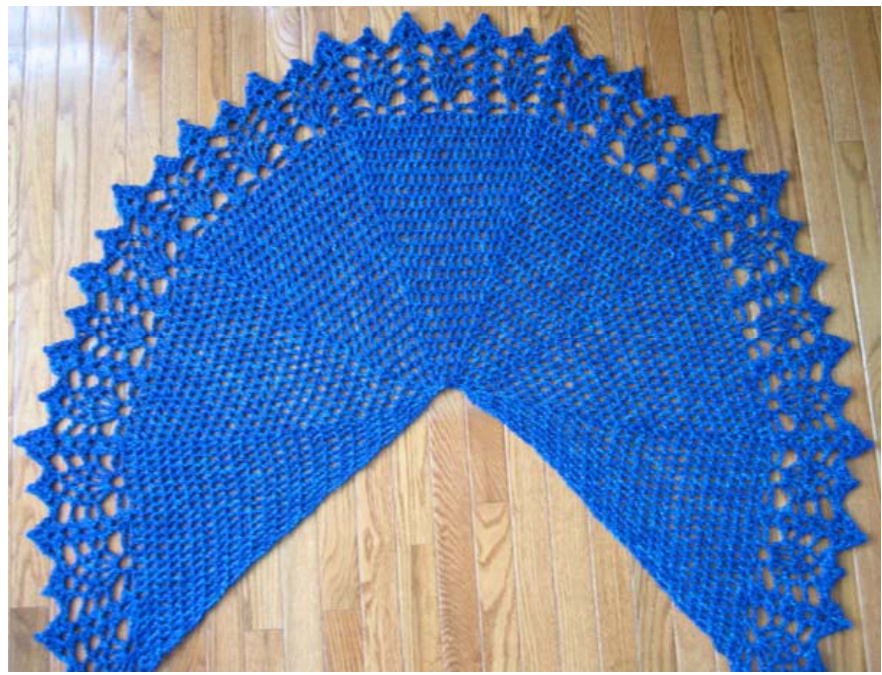
INSTRUCTIONS
(A) LONG VERSION
Shawl is made from the top down, beginning at back neck, with no obvious RS or WS. Create seven panels between the “spokes" of $8\,\lor$ increases, resembling the segments of an orange slice. Each row adds 7 stitches to the count. If you have trouble seeing where your Vs are at in each row, use lengths of contrast yarn to mark the space between the two stitches of each V, wrap markers up as you go. BODY With Boucle Blend Il and K-10.5 $.6.5\;\mathrm{mm}$ ) hook, Fsc 8, turn and begin to work along "sc" edge of foundation. ROW 1: [Ch4 (counts as edc), edc in first sc] for beginning V, V in each of next 7 sc, turn-8 Vs (16 sts) ROW 2: [Ch4,edc in first V]forbeginning V,[edc in next sp between edc, Vin next ]7times, placing last V in turning ch sp, turn - (23 st) ROW3: Ch4,edc in first V, [edc in next sp between edc to next V, VinV]7times, placing last Vin turning ch sp, turn - (30 st) ROW 4-23: Repeat Row 3 for 20 times (or until desired length) - (170 st)
EDGING
Because the lace edging is worked the same way as the mesh, into the spaces between stitches, it needs [a multiple of the pattern repeat] plus 2. The long version uses Strawberry Lace on a multiple of 8 stitches.
THE ALL SHAWL
ROW1: Ch 3, (dc, ch 2, 2 dc) in first sp between stitches for beginning shell,\* ch 3, skip next 2 sp, sc in next sp, ch 3, skip next sp, sc in next sp, ch 3, skip next 2 sp, SH in next $\mathsf{s p}^{\star}$ ; repeat from \* to $\star\ 20$ times, placing last shellin turning ch sp, turn - 21 lace repeats ROW 2: Ch 2, $\mathrel{^{\star}\mathsf{S H}}$ in SH, ch 1, skip next ch-3 sp,[tr, ch 1]5times in next ch-3 sp, skip next ch $\cdot3\;{\mathsf{s p}}^{\star}$ ; repeat from \*to $\star\ _{20}$ times, SH in last SH, turn. ROW 3: Ch 2, $^{\star}{\sf S H}$ inSH, ch1, skip next ch-1 sp, s in next ch-1 sp, [ch3, sc in nextch-1 sp]3times, ch1, skip next ch $1\ {\mathsf{s p}}^{\star}$ ; repeat from \* to $\star\ _{20}$ times, SH in last SH, turn. ROW 4: Ch 2, $^{\star}{\sf S H}$ in SH, ch 2, skip next ch1 sp, sc in next ch-3 sp, [ch3, scin next ch-3 sp] 2 times, ch2, skip next ch $1\ {\mathsf{s p}}^{\star}$ ; repeat from \* to $\star\ _{20}$ times, SH in last SH, turn. ROW 5: Ch 2, $^{\star}{\sf S H}$ inSH, ch3, skip next ch-2sp, [s innext ch3sp, ch3] times, skip next -2 $\mathsf{s p}^{\star}$ , repeat from \* to $\star\ 20$ times, SH in last SH, turn. ROW 6: Ch 2, \*PICOT FAN in ch-2 sp of next shell,ch 1, sc in next ch-3 sp, ch 1, PICOT FAN in next ch-3 sp, ch 1, sc in next ch-3 sp, ch $1^{\star}$ ; repeat from \* to $\star\ 20$ times, PICOT FAN in ch-2 sp of last shell, fasten off. Weave ends and block shawl for most attractive finish. Taking the basic pattern for the Long All Shawl, you can begin tweaking it for different yarns and styles as I have below.
(B) SHORT VERSION
SWTC Amaizing is on the heavy side of ball band number 3 (light). In my hands it works to a light worsted gauge. Any tighter and the fabric will be too thick and stiff.
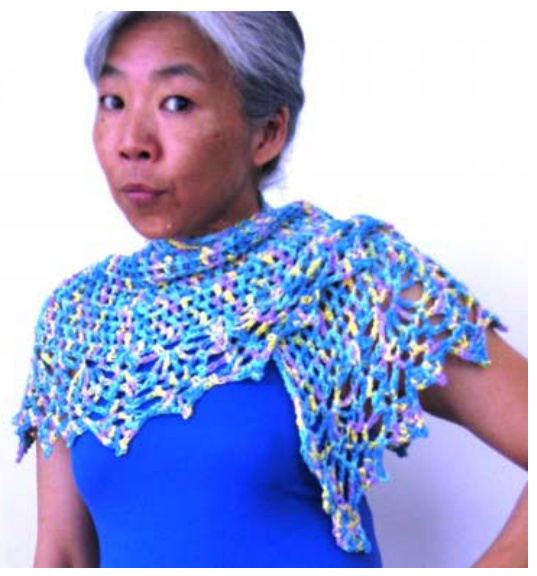
With SWTC Amaizing and J-10 ( $\left(6\;\mathsf{m m}\right)$ hook, work same way as Long version for 17 rows total for the body (128 stitches). Alter the Strawberry Lace to use a 9-stitch repeat as follows, then work edging ROwS 2-6 with fewer repeats. SHORT VERSION EDGING ROW 1: Ch 3, [dc, ch 2, 2 dc] in first sp between stitches for beginning shell,\* ch 3, skip next 2 sp, sc in next sp, ch 3, skip next 2 sp, sc in next sp, ch 3, skip next 2 sp, SH in next $\mathsf{s p}^{\star}$ repeat from \* to \* 13 times, placing last shell in turning ch sp, turn - 14 lace repeats
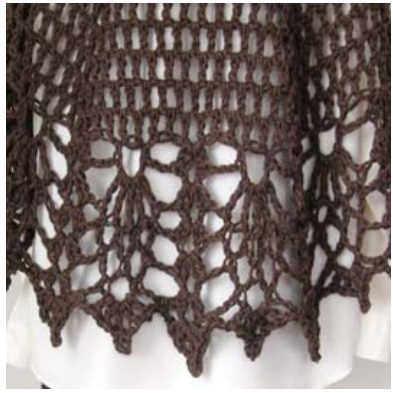
(C) CHUNKY VERSION
With Classic Elite Duchess and M $(9\,\mathsf{m m})$ hook, work same way as Long Version for 15 rows total for the body (114 stitches); work lace edging same way as Long Version for 14 lace repeats.
(D) FUNKY VERSION
I made this shawl many years ago with Lion Brand Homespun and L $(8\,\mathsf{m m})$ hook. I enjoy a gang of flirty fringe now and again, but frankly this is one yarn you DON'T want to cut because it shreds so easily. Besides, in order to balance your fringe with the chunkiness of the stitch, you'd have to cut LOTS of strands and tie thick knots. This crocheted fringe is a neat alternative. It's a major pain in the butt to work, but the resulting worminess is worth the struggle. At that time I used a normal double crochet for the mesh stitch instead of extended double crochet, but the pattern and shaping are the same. Begin body mesh rows with ch 3 (counts as dc); substitute dc for the edc in mesh stitch, work for 17 rows total for the body (128 stitches); omit lace edging, turn and continue with WormFringe below.
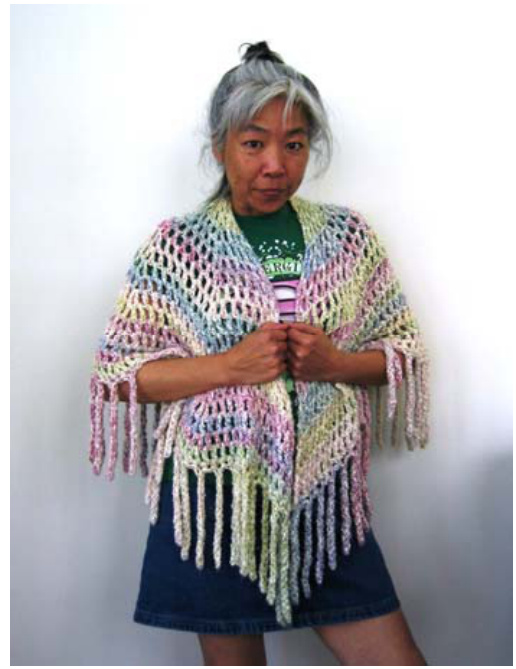
WORM FRINGE: After completing mesh stitch body, turn. Ch1, s infirst sp, \*[ch 15, sl st in $2^{\ n d}$ ch from hook, sl st in remaining 13 chs] for worm, sc in each of next $2\,{\mathsf{s p}}^{\star}$ ; repeat from \* to \* across, placing last sc in turning ch sp, make worm, fasten off - 64 worms To my eye and for my height, a $6"$ fringe looked balanced with the $18"$ mesh body. But if you have different proportions in mind simply make more chains for longer worms or fewer chains for shorter ones.
THE ALL SHAWL
NOTE ABOUT BLOCKING
Just do it. Things just plain look and drape better after blocking. Blocking gives your stitches a chance to lock into place and opens up the stitch pattern. Blocking is also a way to coax your garment into the shape you want. When the yarn is washable I wet block nearly everything I crochet, whether it looks like it needs it or not. Completely immerse the piece in a sink of cool water without wringing or twisting. I add a tiny drop of lavender scented or other sweet-smelling shampoo or body wash to the water, not enough to suds up or need additional rinsing. If you want you can use products made for this purpose. Allow the water to drain out. The next part is tricky and you gotta have a washing machine close by! Gather up the piece in a big towel and dash to your washing machine, the lid of which is already flipped open to expedite the process. Put the garment in the machine and run a short spin only cycle. This will not agitate or stretch the yarn, only spin out the excess water. If you don't have a separate short spin cycle you can manually stop the spinning when you no longer hear the swishing of water. If you don't have a machine handy, roll up the piece in dry towels and press out as much water as you can. Take the damp piece and spread it out on another big towel on a flat surface. Gently but insistently pull, pat and prod your garment into the shape you want, measuring against the pattern schematics or finished measurements given. I never feel the need to pin or otherwise nail down my crochet, but feel free to do this if you want.Allow to dry completely. Yarns react differentlyto this process. Most wools willstretch horriby with blocking, but when dry they sometimes do and sometimes don't shrink back, so avoid stretching wools too much. Cotton also can stretch when wet, but most will dry nicely to shape. One yarn that scares me is bamboo. Some bamboo yarns will seize and shrink when wet. YIKES! But most will relax back when dry. Most acrylic yarns remain the same wet and dry and it often seems a waste of time to block, but I do anyway.
MAKING THE ALL SHAWL ALL YOURS
Just do it. With your choice of yarn and appropriate hook you can make your perfect personal shawl. Often our decisions are dictated by the amount of yarn on hand; been there more times than I care to admit. (Why Oh Why didn't I get the extra balls when I had the chance?). You learn to be flexible. So dig deep into your yarn stash for some cool yarns, search your stitch guides or favorite lace patten books for a brilliant edging to explode. Go, Go, GO!
HOW MUCH YARN?
Here are some jumping off places for substituting yarns, suggesting approximate amounts to get an approximately 25" back length garment like the Long Version. This design as written needs about 700 yards of worsted to heavy worsted weight yarn, perhaps 8 or so 1.75 $0Z/50\ \mathfrak{g}$ balls. At this gauge the lace edging is well exploded, deep and in your face.
THE ALL SHAWL

For DK or sport weight you would need perhaps 900 yards, enough for crocheting more rows to achieve the same length. In proportion, the edging will be shorter and more delicate.

For fingering or lace weight yarn you might need 1200 yards and lots more patience. Proportionally the lace edging would be so insignificant that you might want to consider adding more rows of Strawberry Stitch. Make the body in mesh to your desired length, possibly 47 rows total (338 stitches). Work Edging Rows 1-5 in same way as for Long Version, except you will have 42 lace repeats. Instead of ending the edging with Row 6, repeat Rows 2-5 for as much lace as you can stand doing, then finish up with Row 6.

To work with chunky/ bulky yarns, really loosen the gauge with a bigger hook than you think, so the resulting fabric has some drape. In shor time you'llfly through the 500 to 600 yards it takes for a good-sized shawl. NOTE: I have never tried this pattern with either thread weight or super bulky yarns (where the gauge is measured in inches per stitch!), but if love working with crochet cotton OR if you're into the instant-er gratification you get with giant gauge or maybe want to hold two, three or more yarns together, this design should work for you as well.

As for yarn requirements for other lengths, it's allup to you and your gauge. Here's a tip from my wonderful, fabulous chief pattern tester and stalwar friend, Diane Moyer. She made the Short Version the same way as mine, only she used Brown Sheep Cotton Fleece, a smooth, worsted weight wool/cotton blend. Her All Shawl took 430 yards.
CANI DO COLORS?
Who says your AllShawl has to be allin one yarn, shade or classic texture? Certainly not me. Go ahead and do your hand-painted, space-dyed, bling-bling, wiggledy-piggledy, wimey-timey, color-happy thing. Make Fibonacci sequence stripes. Hee hee. Release your inner Crayola monster.
CANI MESS WITH THE MESH?
In the loosened gauge of this pattern, the fabric is open and drapey. For a warmer shawl, don't switch to a smaller hook and gauge down. I suggest you make the mesh in double crochet instead of the extended double crochet as I did in the Funky Version (D). This willgive you a denser mesh without sacrificing drape. Be advised that this also results in a fuller circle (the mesh gets wider faster). You will have to make more rows than written to get the same length, and again your stitch count and yarn requirements will be different. For an airier, more open mesh, you can add a ch 1 between the stitches of the mesh pattern, beginning the mesh rows with ch 5 (counts as edc, ch 1). This results in a more expanded gauge and a generally fuller circle. Also adjust the count for lace patten repeats, so the lace is full enough across the wider mesh. I'd go with using 6 ch-1 spaces per repeat (see suggestion below).
EDGING FOR OPEN MESH
ROW1:Ch3, [d, ch2, 2d] infirst ch-1 spforbeginning shel, \* ch3, skip next ch-1 sp,sc inext ch-1 s. ch 3, skip next ch-1 sp, sc in next ch-1 sp, ch 3, skip next ch-1 sp, SH in next ch $1\ {\mathsf{s p}}^{\star}$ repeat from \* to \* as needed, placing last shellin turning ch sp, turn.
THE ALL SHAWL
BIGGER, PLEASE
As written, the shawl is roughly a three-quarter circle. You may want a fuller circle, either to fit a wider body or for more fabric to wrap around and throw. Simply add a repeat or even two repeats to the mesh; to add one panel to the width, Fsc 9, in ROw 1 make 9 V's, then work all the following mesh rows with the extra repeat (each row adds 8 stitches to the count). Your stitch count for the body will be different and obviously you will need more yarn for the same length shawl.
HAPPY ENDINGS
The beauty part is that you can stop the body wherever you want and then get on with the fun of trimming it. Use the stitches of the last row as your canvas for adding any lace or trim you want. Basically you want to hit the magic number of [a multiple of your pattern stitch] plus two stitches if you're continuing to work in the space between stitches. But feel free to make your trim into the last row of stitches as normal. In that case you'll need your last body row to have [a multiple of your pattern stitch] plus one stitch. Since the outer edge of the shawl body is rounded, unless your choice of edging is already designed to fit around a curve, take care to slightly squeeze on your edging so the bottom doesn't warp and pucker. In other words, use up fewer stitches of the body for each repeat of edging than if you were crocheting straight and flat, fewer than the number of foundation chains given in a stitch guide. For example, the stitch guide for the Strawberry Lace I used here calls for 12 foundation chains per repeat, but I work it over 8 or 9 stitches. Hey,if the numbers don't add up, just adjust as you go across, skip or not skip stitches as needed, to make it work.
EEEEEEEEEEK!
I try to max out the amounts of yarn I have within reasonable limits. Certain samples here worked out the way they did because I used up every little bit of every ball. Sometimes you just plain run out of yarn. UHOH! Let's say you've made the 23 rows of the Long Version body as written, but there's not enough yarn to do the whole edging as written. You could just rip back some of your mesh rows, but here's another option. With around one ball (100 or so yards) of the same yarn or with a totally different, contrasting, coordinating or goofy yarn you can finish up with a short, sweet edging that gives a pretty scalloped effect. Over the 170 stitches, work just the last row (ROw 6) of the edging, using 6 spaces for each repeat. Sort of like this. ONE ROW EDGING: Ch 4, [dc, ch 1, dc, picot, ch 1, dc, ch 1, dc] in first sp between sts, \*ch 1, skip next 2 spaces, sc in next sp, ch 1, skip next 2 spaces, PICOT FAN in next $\mathsf{s p}^{\star}$ ; repeat from \* to $\ast\,27$ times, ending with PICOT FAN in turning ch sp, fasten off. Simple and perfect.
IF YOU'RE READY...
For the ultimate expression of the AlShawl, go and get this free pattern download and see Coco Bay, designed in three shades of NaturallyCaron.com Spa.
THE ALL SHAWL
ABOUT THEAUTHOR
Blame my mother for first putting crochet hooks (and knitting, embroidery, cross-stitch, needlepoint and sewing needles) in my hands. I was never a girly-girl and for most of mylife hardly gave a thought to my clothes or to accessorizing. If you'd asked me twenty years ago I'd have said I'd rather eat worms than wear a shawl. How times and tastes have changed. Since I rediscovered crochet and found ways to make shawls that stay on your shoulders I have a much improved opinion of these graceful, beautiful and, yes, girly garments. The first things I can claim to have designed were shawls, wraps, stoles and capes. These shapes were the logical, practical and functional way to explore my fascination with the lace stitches, motifs and doily patterns Isaw in guides, books and magazines (yes, my children, before there was in internetl). Once Ihad enough experience with these simple shapes I expanded into my current modus operandi of seamless, top-down garments. My books, Amazing Crochet Lace and Everyday Crochet , both from Potter Craft, are filled with the lessons I learned through much trial and error, and can help you master the making of crochet wearables. I am a proud professional member of the Crochet Guild of America (CGOA) (www.crochet.orq) and also belong to The National NeedleArts Association (TNNA) (www.tnna.orq). Online you can find me lurking on Ravelry (www.ravelry.com), Crochetvil (www.crochetville.org), and CrochetMe (www.crochetme.com) and on my blog, Everyday Crochet (doriseverydaycrochet.blogspot.com). Oh, and if you crochet up an All Shawl that you're particularly proud of, please post about it. Plenty of photos with. I'd love to add your favorite lace edgings, innovations and pattern tweaks to the download so all can appreciate and share your genius! This design and pattern is a work in progress.
ACKNOWLEDGEMENTS
My thanks to Diane Moyer, my best (my only) pattern tester. She has an uncanny way of taking a step back and seeing the Big Picture. Ialternately love her and despise her for finding and gloating over my errors. :D And major kudos to Karen Manthey theother half of my brain for the stitch diagrams on the last page.
THE ALL SHAWL
STITCH DIAGRAMS
by Karen Manthey
